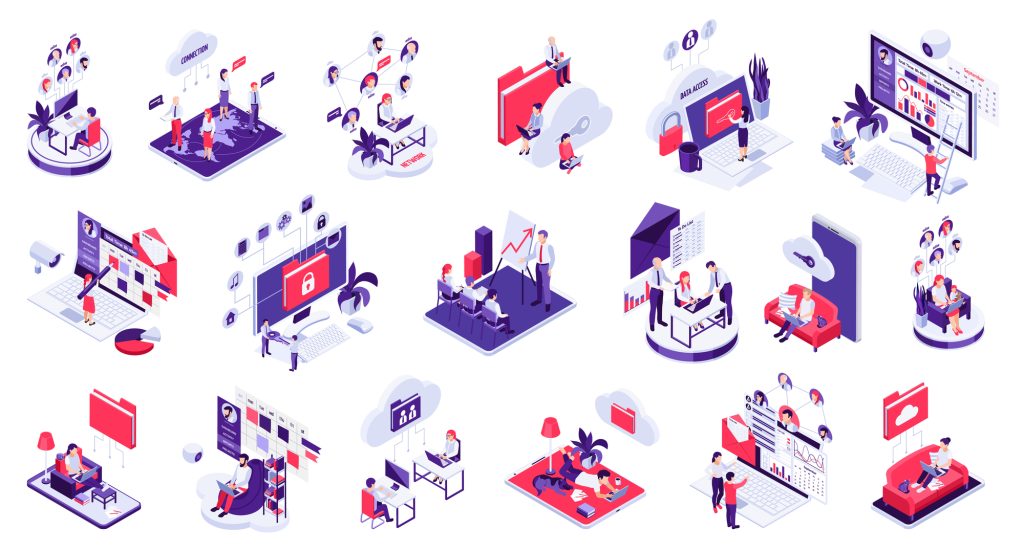- July 12, 2023
- Catagory productivity
Employees want to work from anywhere, but need the right remote tools
The right tool for the right job matters in a hybrid workplace – not only do those returning to the office expect to have the right applications to be productive, but they want the right remote tools when working from home.
In fact, a new study by Atlassian found that employees want remote work tools rather than in-office mandates, and half those who employees who work remotely rather than the office say they don’t have the remote tools they need. The study also found that in-office mandates are unpopular with employees.

These finding are based on survey responses from 1,000 knowledge workers in the United States and Australia. More than two thirds work remotely at least once per week, but only just over half of those remote workers said their employer provides them with remote tools for collaboration. Of those who are provided with remote tools, 26 per cent said those tools aren’t necessarily right for their job or they can’t be effective with those collaboration applications because they don’t have sufficient training.
The Atlassian report noted that the lack of productivity reported by employers is not the fault of remote work – as employers claim – but that they aren’t providing the right remote tools to make offsite, distributed employees as productive as they can be.
Atlassian also noted that the companies that have issued back-to-office mandates have generally not provided hard data that demonstrates employee productivity has declined, and that there is research to show that workers feel more productive when working from home.
But there is conflict between companies and their employees over in-office mandates along with fears of operation silos and a feeling from employees that they are not being supported. This conflict isn’t going to be resolved by forcing people to go back to the office, given that in-office mandates aren’t popular, according to Atlassian. Its survey found that 92 per cent of respondents said they have some form of “in-office mandate,” while 46 per cent are going into the office because their company mandates it, not because they want to.
The survey also found that even in those companies where employees are given a choice, a quarter of respondents feel pressure to go into the office, while 10 per cent worry that they will be perceived as less productive or not adequately committed to their work if they opt to work remotely.
Meanwhile, S&P Global’s 2022 Voice of the Enterprise: Workforce Productivity and Collaboration survey echoes the Atlassian findings and that most employees would prefer to work at home some of the time and that productivity hinges on having the right remote tools.
The consensus appears to be that there’s no going back to the pre-pandemic days of everyone being in the office five days a week. Now matter where employees work, they need the right tools, and ultimately the focus should be on productivity, not hours spent in the office.
A managed service provider is ideally equipped to help you optimize your distributed workforce so you can deploy the right remote tools while maintaining a strong security posture.
- October 17, 2021
- Catagory PCaaS
PC-as-a-Service (PCaaS) streamlines and procurement and enhances productivity
With the trend toward remote work evolving to a hybrid office modelv, the case for small and medium-sized businesses to embrace PC-as-a-Service (PCaaS) is more compelling than ever.
Businesses need their employees to be as productive as possible no matter where they are without worrying if their PC workstations are fast enough, secure enough or properly connected to the data and applications they need to get things done.
PCaaS offers many benefits, allowing you to scale up your employee PC footprint as quickly as needed to support essential on-site employees, remote workers and hybrid offices with the latest and greatest Windows-based desktops and laptops.
Predictable costs and more secure data

Moving to PCaaS eliminates the upfront of cost of buying PC workstations and reduces the time and effort necessary to source and negotiate with vendors. Guided by your requirements, a managed service provider acquires the best hardware on your behalf, and you subscribe instead of buy through a monthly leasing model.
A PCaaS subscription provides predictable budget because your costs are fixed over the course of the agreement rather than occasional small or large capital expenditures and all the associated costs with deploying, managing, and maintaining a fleet of workstations. The cost savings of embedding the cost of equipment into a monthly fee add up quickly because lifecycle management of hardware becomes the responsibility of your service provider, including device disposal. You also have the flexibility to scale up or down as needed without worrying about whether you have the available management expertise or devote resource to sourcing and negotiating with vendors.
PCaaS frees up your own IT teams for more strategic projects aligned with business objectives because you can trust that a managed service provider will provide the technicians needed to manage any hardware and software regardless of location, including on-site troubleshooting or remote updates and maintenance. This also translate into reduced downtime because this IT support is available 24/7. Productivity is also enhanced because any new device that lands on an employee’s desk is pre-configured to desired specifications with all needed apps necessary for them to do their job.
Another added benefit to PCaaS is enhanced data protection due to better business continuity and security. The right service provider will also offer off-site data so that in the wake of a natural disaster or power loss they can easily restore critical data and re-provision your equipment quickly so there’s little to no disruption to your business operations. PCaaS also encompasses security safeguards such as hardware-based security measures, secure authentication for users, and data encryption and malware detection/remediation as part of any device deployment. By managing your fleet from a central location, your provider can update all devices with any security patches remotely, as well as keep a real-time inventory by tracking their location and status.
Workstations on demand
Supra ITS’ PCaaS, also known as “Workstation-as-a-Service” (WaaS) takes on the day-to-day management of all your employee workstations, no matter where they work or what they do. We manage any software updates and hardware upgrades, answer any technical support calls, and reconfigure the PC as needed to improve productivity and meet business objectives. This enables both your employees and IT staff to focus on strategic initiatives that drive revenue for the business rather than get bogged down with PC troubleshooting.
Because we automatically deliver the latest patches and updates to every endpoint in alignment with robust security policy and any mind any regulatory requirements that govern your industry, you can have peace of mind your business is protected without any barriers to productivity. Our sourcing strategy future-proofs your business with workstations that will be able to run your core applications for years to come.
- January 14, 2021
- Catagory Collaboration
IT teams must balance remote work productivity and security
It’s still open for debate as to whether remote work is here to stay for everyone, or if a year from now everyone will back in the office. Reality is probably somewhere in between, which means IT teams must find a balance between security and keeping employees productive.

In many ways, the Covid-19 pandemic accelerated trends already in play as better connectivity and cloud computing have made it easier for workforces to be more geographically distributed. Instead of corporate satellite offices with small teams, however, we have home-based offices of one.
IT teams need to assume that there will be at least a hybrid workforce for the foreseeable future and that security for remote work will continue to be a high priority. The trick is to keep the organization secure without impeding productivity.
Hybrid workforces work odd hours
The age of remote work is more than just applying security to more endpoints accessing the corporate network. IT teams need more management tools to support remote workers while extending support hours as employees embrace less traditional schedules to accommodate their home life. Digital workers are expected to embrace “time blocking” and “time slicing” to juggle all their commitments.
IT teams will need to bolster their own remote collaboration capabilities so members can work more efficiently with each other, but also with other departments, such as human resources to onboard new staff remotely. This includes provisioning new remote workers with corporate-issued equipment or configure their personal devices.
In addition to supporting remote work, we are likely to see a move toward “hoteling,” which is when employees book an on-site work site for a few hours or a day. These facilities must also be equipped and provisioned with connectivity and hardware, as well as maintained for cleanliness.
This hybrid workforce means IT teams must rethink how they deliver service to employees and view their relationship as partnership that supports productivity for everyone—this includes delivering a high-quality user experience that helps employees work better without compromising security.
Productivity should not compromise security
The trend toward more remote was always going to have security implications.
In the early days of the pandemic, the focus was getting employees productive at home. However, the price tag appears to have been a spike in malware incidents and other poor security behaviors. According to Wandera’s Cloud Security Report 2021, 52 per cent of organizations dealt with a malware incident in 2020 compared to 37 per cent in 2019.
The rise in incidents can be attributed to a more relaxed work environment for employees, who are likely using a single device for most of their online activities—personal and professional. Employees feel free to install whatever applications they want, whether it’s their device or one issued by the company. Adopting cloud-based and Software-as-a-Service (SaaS) applications also impact security as lines of business spin up apps for their own uses without oversight by the IT department.
Keep security simple to enable employees
As much as remote work has created new threats for security, the solutions for IT teams aren’t all that different.
Regardless of they work, security awareness training for employees continues to be a key tool for defending against threat actors. IT teams must engage regularly with users to remind them of how they should log into applications, which applications are approved by the organization, and how they should report an incident if it occurs. Employees should understand they play a role in protecting the organization and its mission-critical business information.
If IT teams are work in partnership with users to balance remote work productivity and security, simpler is better so that any solutions implemented enable a pleasant user experience. This encourages users to follow protocols rather than bypass them because they’re seen as a barrier to getting their work done.
Sanjeev Spolia is CEO of Supra ITS
- November 16, 2020
- Catagory Collaboration
7 Ways to Make Remote Collaboration Easier For Your Teams
If you’re still struggling to optimize remote collaboration across your now virtual organization, you’re not alone. However, it does look like it’s the new normal for the foreseeable future, so you should prioritize finding ways to improve how your team works together remotely.

There are several ways you can improve remote collaboration. Some of them involve leverage technology, but many of them also involve managing people and understanding what they need to be successful to work from home.
- Focus on results, not hours on a timecard: If you’re used to measuring how productive people are by seeing bums in chairs, moving to remote collaboration has probably been difficult for you. Rather than measure productivity by how many hours employees are clocking, start measuring performance based on output. If the work is getting done, you’re already closer to optimizing remote collaboration.
- Create a buddy system: Some employees adapt to remote work better than others, and struggle because no longer have their peers to support them in the office. Consider pairing people up with someone else in a different department with relatively the same seniority so they have someone else as a sounding board to bounce ideas, concerns and frustrations off of, and ultimately find solutions via the pairing.
- Be mindful of meetings: Most meetings could have been an email, and remote work doesn’t change that. Having virtual ones might look like a way to replicate the camaraderie of the office, but meetings should still be focused and organized with a clear agenda and purpose. If there’s multiple people involved, have a facilitator to keep things on track and be sure everyone comes away clear on the next steps.
- Check in daily: While full-blown meetings should be few and far between, take advantage of remote collaboration tools such as Microsoft Teams or Slack to let everyone know what you working on that day and your pressing priorities. This enables everyone to better understand everyone else’s pressures and even step up to help if they can. It’s also a good way to structure your day so you get what you need to get done without getting sidetracked, and it’s output focused.
- Streamline communications channels: More isn’t better, and like an overflowing email inbox, having too many alerts and notifications in a remote collaboration tool is counter productive. Let employees set boundaries around how connected they want to be while they work so the can be productive, but also set up a single channel everyone must subscribe to so they get the company-wide information they need on a daily basis.
- Get things done and be accountable: Whether it’s a next step agreed upon in a meeting or regulator best practices, it’s important to follow through on things. Keep track of commitments in a transparent way so everyone can take responsibility for what they agree to do.
- When in doubt, over-communicate: As much as we don’t want employees to be overwhelmed notifications, alerts and messages in remote collaboration tools, don’t assume your colleagues know what they need to now. Use your daily check in and the channels at your disposal to communicate everything you think might be valuable, as things can fall through the cracks when you don’t have daily, in-person interactions.
Full-time remote collaboration is new for most people, so at the end of the day you need to have empathy and remember that their home office environment may be different than yours. While it’s important to focus on getting things done and accountability, it’s also helpful to cut everyone a little slack during these stressful times.




 Latest Blogs
Latest Blogs FAQ
FAQ